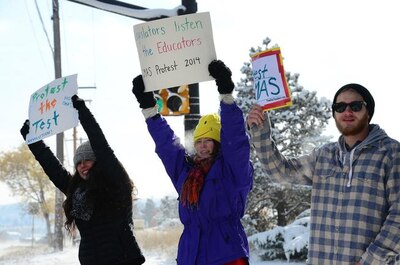The large number of students who skipped this spring’s state standardized tests is throwing a wrench into the high-stakes process of determining the quality of Colorado’s schools.
State education department officials putting together the latest annual school quality ratings have flagged more than half of the state’s districts and one-third of its schools for test participation below the federally required minimum of 95 percent. The ratings are preliminary, and districts and schools may appeal before they are finalized this winter.
While districts that fell below that participation mark will not face negative consequences under Colorado law, state officials are urging the public to proceed with caution in considering ratings in places with high testing opt-out rates.
Some school leaders and advocates are crying foul, however, arguing that it’s irresponsible to rate schools based on incomplete data. Meanwhile, longtime critics of the ratings are seizing on the development to renew calls to reform the the system.
Colorado’s high opt-out rate “raises suspicion around all the data that is being shown to folks,” said Oliver Grenham, Westminster Public Schools’ chief academic officer, a longtime critic of the state’s accountability system.
Colorado rates schools and districts based primarily on results from the state’s English and math tests. Other factors, such as graduation rates, play a lesser role.
The ratings are used to identify schools and districts that are falling behind the rest of the state academically. If those schools and district’s don’t improve within five years, the state is supposed to step in to force more drastic changes, such as closing low-performing schools.
That system to rate, rank and compare schools was created in 2009, when nearly every student took the state’s standardized exams. While there have long been philosophical divides among educators and advocates on the value of the ratings, most everyone agreed that the data was valid.
That isn’t the case now. State officials have urged caution with the testing data, in part because of low participation numbers, since the first results of the state’s new assessments were released in 2015.
“When it’s comparative and not comparable, how do you continue to trust that we’re not causing more harm than good?” said Charlotte Ciancio, superintendent of the Mapleton School District. “It’s a question of fairness.”
Changes, challenges to the system
State education officials for months have been working to retool the state’s accountability system to account for the changes in the state’s testing system.
In 2015, Colorado began using the PARCC exams to measure student’s understanding of English and math. That same year, lawmakers codified the right for parents to exempt their students from the exams. In addition, schools would not be held liable if their participation rates dipped below 95 percent because of parent refusals.
“We’re trying to implement the accountability law in a very different context and we’re trying to figure out what that means now,” said Alyssa Pearson, the state’s chief accountability officer.
Districts and schools that had too many students excused from the test will receive the rating of “insufficient state data, low participation.”
According to preliminary numbers, eight small districts and 32 schools will receive that rating.
“(Opt-out) has certainly made it more challenging to run the accountability system, because we just want to be very transparent about what all of this means,” Pearson said.
Another 74 districts and 486 schools essentially will have an asterisk next to their rating denoting low participation, according to preliminary ratings.
State officials expect those numbers to rise, however.
Some 20 districts, mostly rural, and 111 schools did not notify the state correctly about the number of students who were excused from the tests by their parents. That error triggered the state to manually lower the ratings.

The state is still required to decrease a school’s or district’s rating if fewer than 95 percent of students who are eligible to take the test and are not excused by their parents skip the test.
School and district officials must now submit new data through an appeals process to have their rating increased.
“We trust that CDE is going to do its best to make this process smooth,” said Michelle Murphy, executive director of the Colorado Rural School Alliance. “But our districts have real concerns about privacy concerns and the administrative burden it places on their already stressed staff.”
State officials have promised an expedited process for those districts and schools.
The largest school district to have its rating lowered because of the coding error —Mesa Valley School District 51 — will ask the state to remove its rating all together.
“We believe the participation rates have caused a situation where our accreditation rating doesn’t accurately reflect our student performance, because only a portion participated in the performance,” said Tony Giurado, chief academic officer for the Mesa schools in Grand Junction.
About 30 percent of the district’s students opted out of the state’s tests, Giurado said.
Other districts may file similar appeals, said Pearson, the state’s accountability officer. In those cases, the state will be examining whether students who took the tests are representative of district students.
Renewed criticism
The release of the state’s preliminary school ratings, especially with the new flag for low participation, is resurfacing criticism of the state’s accountability system.
“One of the opt-out movement’s goals in Colorado was forcing change in the state’s so-called accountability system,” said Bob Schaeffer, director of the National Center for Fair & Open Testing, a critic of standardized testing. “And the first step is raising questions about its validity, which the asterisks certainly do.”
Several school leaders say they hope the new federal education law, the Every Student Succeeds Act, will let Colorado lawmakers return rating school quality to the district level.
A group of rural schools has already begun testing a new accountability system that relies on both state and local data, including parent and teacher surveys.
The Cherry Creek School District, a hotbed of the opt-out movement, is developing its own rating system this year, said Judy Skupa, the district’s assistant superintendent.
Similar to Denver Public Schools’ own school rating system, Cherry Creek will rate its schools and provide the information to school staff, parents and students. While still in development, the ratings will focus on key educational milestones like how many students are reading by third grade.
Skupa said one of the reasons why Cherry Creek is developing its own system is because the district believes the state’s ratings are imbalanced and don’t measure what’s actually happening at the school.
“I think what we see in this system, particularly for K-8, the rating is totally dependent on a state assessment. We are so much more than a state assessment,” she said. “I don’t think we have thought outside of the box.”
Absent new legislation, state officials are left to manage the accountability system within the confines of the 2009 law.
“We know we don’t have the whole story,” said Pearson, referring to districts with high opt-out rates. “We need to figure out what we value in accountability within our new context, and how we want to move forward with accountability with this context of opt-out.”


